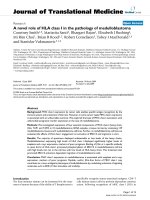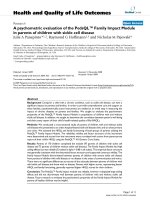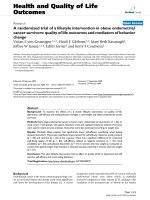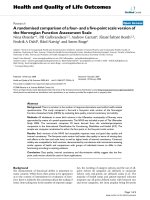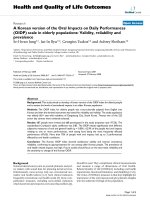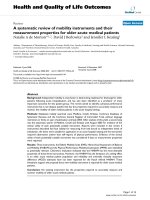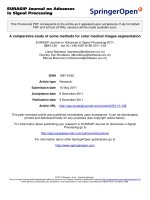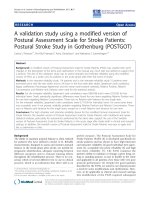báo cáo hóa học:" A biomechanical study of plate versus intramedullary devices for midshaft clavicle fixation" pot
Bạn đang xem bản rút gọn của tài liệu. Xem và tải ngay bản đầy đủ của tài liệu tại đây (488.9 KB, 5 trang )
BioMed Central
Page 1 of 5
(page number not for citation purposes)
Journal of Orthopaedic Surgery and
Research
Open Access
Research article
A biomechanical study of plate versus intramedullary devices for
midshaft clavicle fixation
S Raymond Golish, Jason A Oliviero, Eric I Francke and Mark D Miller*
Address: Department of Orthopaedic Surgery, University of Virginia Health System, Charlottesville, Virginia, USA
Email: S Raymond Golish - ; Jason A Oliviero - ; Eric I Francke - ;
Mark D Miller* -
* Corresponding author
Abstract
Background: Non-operative management of midshaft clavicle fractures is standard; however,
surgical management is increasing. The purpose of this study is to compare the biomechanical
performance of plate versus intramedullary fixation in cyclic bending for matched pairs of cadaveric
clavicles. We hypothesized that the biomechanical properties are similar.
Methods: Eight sets of matched clavicles with vertical, midshaft osteotomies were prepared from
fresh, frozen cadavers. A 3.5 mm dynamic compression plate or a 3.8 or 4.5 mm intramedullary
device were used for fixation. Clavicles were loaded in a four-point bend at 6 different loads for
3000 cycles at 1 Hz starting with 180 N and increasing by 180 N with sampling at 2 Hz. Failure was
defined as 10 mm of displacement or catastrophic construct failure prior to 10 mm of displacement.
Results: Between constructs, there was a significant difference with large effect size in
displacement at fixed loads of 180 N (P = 0.001; Cohen's d = 1.85), 360 N (P = 0.033; Cohen's d =
1.39), 540 N (P = 0.003; Cohen's d = 0.73) and 720 N (P = 0.018; Cohen's d = 0.72). There was a
significant difference with large effect size in load at fixed displacements of 5 mm (P = 0.001;
Cohen's d = 1.49), 7.5 mm (P = 0.011; Cohen's d = 1.06), and 10 mm (P = 0.026; Cohen's d = 0.84).
Conclusion: Plate constructs are superior in showing less displacement at fixed loads and greater
loads at fixed displacements over a broad range of loads and displacements with cyclic four-point
bending. The clinical relevance is that plate fixation may provide a stronger construct for early
rehabilitation protocols that focus on repetitive movements in the early pre-operative period.
Background
Clavicle fractures comprise 5–10% of all skeletal fractures,
and 80% of these occur in the middle-third [1]. These frac-
tures result from a blow to the shoulder causing axial
loading [2]. The standard of care is closed treatment with
sling and swathe; however, recent studies have found
higher rates of delayed union, nonunion, shoulder pain,
and shoulder weakness with non-operative care [3]. Risk
factors for poor outcome with non-operative treatment
include shortening, initial displacement, fracture commi-
nution, and age. The indications for surgery include the
need for earlier functional mobilization in the patient
with an isolated injury [4] in addition to open fractures
and the polytraumatized patient.
Published: 16 July 2008
Journal of Orthopaedic Surgery and Research 2008, 3:28 doi:10.1186/1749-799X-3-28
Received: 17 September 2007
Accepted: 16 July 2008
This article is available from: />© 2008 Golish et al; licensee BioMed Central Ltd.
This is an Open Access article distributed under the terms of the Creative Commons Attribution License ( />),
which permits unrestricted use, distribution, and reproduction in any medium, provided the original work is properly cited.
Journal of Orthopaedic Surgery and Research 2008, 3:28 />Page 2 of 5
(page number not for citation purposes)
For operative treatment, open reduction and internal fixa-
tion with a 3.5 mm dynamic compression plate is the
standard; however, intramedullary fixation is a less inva-
sive alternative. A retrospective clinical study by Wu et al.
compared plate to IM fixation for aseptic nonunions [5].
A biomechanical study by Proubasta et al. compared a 6-
hole 3.5 mm dynamic compression plate to a 4.5 mm
intramedullary Herbert screw [6].
Clinically, cyclic bending is a likely model of construct
failure, especially in the setting of early functional mobi-
lization. Loosening at the bone-implant interface, fatigue
failure, and broken hardware are clinical anecdotes shared
by surgeons caring for patients with these injuries. No bio-
mechanical study has compared plate to intramedullary
fixation in cyclic bending. The purpose of this study is to
compare plate fixation versus intramedullary fixation in
cyclically loaded clavicles in a four-point bend with
sequentially increasing loads. We hypothesized that the
biomechanical properties are similar.
Methods
Eight sets of paired clavicles were obtained from 8 fresh,
frozen cadavers. There were 5 male and 3 female speci-
mens in the age range 37 to 68 years. Vertical osteotomies
were made at the midpoint using an oscillating saw. A sin-
gle clavicle from each matched pair set was randomly
assigned to either the intramedullary fixation technique
or the plating technique, and the contralateral clavicle was
assigned to the other fixation technique.
Seven-hole, 3.5 mm titanium dynamic compression
plates (ACE/Depuy, Warsaw, IN, USA) were contoured to
the superior surface of reduced clavicles. The plate size
was chosen to be the largest width that would contour
smoothly to all cadavers samples without hardware prom-
inence beyond the cortical borders. AO technique was
used to place 3.5 mm cortical, fully threaded titanium
screws; holes were drilled, tapped, and measured prior to
screw selection. Six cortices of fixation were acquired on
either side of the osteotomy, after positioning the middle
hole of the plate over the osteotomy site to balance three
holes evenly on either side. The Rockwood Pin (Depuy,
Warsaw, IN, USA) was used as the intramedullary device
to fix the osteomized clavicles. Using the technique rec-
ommended by the implant manufacturer, clavicles were
repaired using either a 3.8 mm pin or a 4.5 mm pin
depending on bone diameter. An attempt to insert a 4.5
mm pin was made, but if the pin proved too large to pass
without binding or fracture, a 3.8 mm pin was passed.
Five pins of 4.5 mm width and three pins of 3.8 mm width
were used.
A custom jig consisting of 2 superior inner arms and 2
inferior outer arms was constructed to load clavicles in a
four-point bend. Figure 1 is a photograph of the jig loaded
with a clavicle for testing. The clavicles and arms were
optimally positioned such that the osteotomy site was at
the midpoint between both the inner and outer arms.
Clavicles were placed with the superior surface contacting
the outer arms and the inferior surface contacting the
inner arms, loading the superior surface of the clavicle in
tension. In order to stabilize this position during loading,
two 0.157 mm K-wires were placed thru the jig and the
clavicle's acromial end.
The MTS-Bionix (Materials Testing Systems, Minneapolis,
MN, USA) servohydraulic testing machine with a 454 kg
load cell was used to load the clavicles while a digital
extensometer measured displacement. The clavicles were
loaded for 3000 cycles at a frequency of 1 Hz starting with
a force of 180N. The loading cycles of 3000 repeats were
incrementally increased by 180N such that the clavicles
were tested at 180N, 360N, 540N, 720N, 900N, 1080N
loads. The extensometer measured the peak and valley of
each load cycle with a sampling rate of 2 Hz. Testing was
stopped after displacement of greater than or equal to 10
mm occurred, after catastrophic failure of the construct at
the bone-implant interface, or at the completion of the
1080N loading cycle. Data analysis was performed with
SPSS 12.0 (SPSS Inc., Chicago, IL, USA) using paired t-
Photograph of clavicle loaded in jig for testing by cyclic load-ing in a four-point bendFigure 1
Photograph of clavicle loaded in jig for testing by
cyclic loading in a four-point bend. Label A denotes the
outer arm. Label B denotes the inner arm.
Journal of Orthopaedic Surgery and Research 2008, 3:28 />Page 3 of 5
(page number not for citation purposes)
tests, Wilcoxon signed-rank tests, chi-squared tests, and
Bonferroni-Sidak multitest correction. An alpha value
(type I error rate) of 0.05 was considered significant.
Power analysis was performed with a beta value (type II
error rate) of 0.20 in order to choose the sample size of 8
matched clavicle pairs as detailed in the results section.
Results
Eight matched pairs of clavicles ranged in length from 147
mm to 175 mm and ranged in diameter from 11 mm to
16 mm. The diameter was measured at the widest point in
the middle one-third of the bone. Table 1 summarizes the
clavicle and test characteristics. Between matched pairs of
clavicles, there was no significant difference in clavicle
length (P = 0.99), diameter (P = 0.35), inner arm place-
ment (P = 0.70) or outer arm placement (P = 0.41) by
paired t-tests. Five right-sided clavicles received the plate-
construct and 3 right-sided clavicles received the pin-con-
struct; there was no significant difference in clavicle-later-
ality versus construct-type (P = 0.48) by chi-squared test.
Loads were measured for serial displacements for both
constructs. Table 2 summarizes the data. For all displace-
ments, the plate constructs had lower mean load. There
was a significant difference between plate versus pin con-
structs for displacements of 5 mm (P = 0.001; Cohen's d =
1.49)), 7.5 mm (P = 0.011; Cohen's d = 1.06), and 10 mm
(P = 0.026; Cohen's d = 0.84) by paired t-tests with Bon-
ferroni multi-test correction (corrected alpha = 0.029).
The use of Sidak multitest correction or Wilcoxon signed-
rank tests did not change the significance at any displace-
ment.
Displacements were measured for several loads for both
constructs. Table 3 summarizes the data. For all loads, the
plate constructs had lower mean displacement. There was
a significant difference between plate versus pin con-
structs for loads of 180N (P = 0.001; Cohen's d = 1.85),
360N (P = 0.033; Cohen's d = 1.39), 540N (P = 0.003;
Cohen's d = 0.73) and 720N (P = 0.018; Cohen's d = 0.72)
by paired t-tests with Bonferroni multi-test correction
(corrected alpha = 0.027). At loads of higher than 540N,
half or more of all constructs had failed. There was no sig-
nificant difference at 900N (P = 0.44 for N = 2 pairs), and
there were no testable data pairs at 1080N. The use of
Sidak multi-test correction or Wilcoxon signed-rank tests
did not change the significance at any load.
The experiment was designed using statistical power anal-
ysis to choose eight cadaver pairs. The power of paired t-
tests is 0.81 for N = 8 by Monte Carlo simulation of 2000
pseudorandom variates from a joint normal distribution
with a large effect size (Cohen's d = 0.8).
Discussion
The main finding of the present study is that plate con-
structs show less displacement at fixed loads and greater
loads at fixed displacements over a broad range of loads
and displacements with cyclic four-point bending. The
clinical relevance is that plate fixation may provide a
stronger construct for early rehabilitation protocols that
focus on repetitive movements in the early pre-operative
period.
During a midshaft clavicle fracture, the anterosuperior
surface experiences tensile forces whereas the posteroinfe-
rior surface experiences compressive forces [7]. Proubasta
et al. compared a 6-hole 3.5 mm dynamic compression
plate to a 4.5 mm intramedullary Herbert screw [6]. They
concluded that there was no difference in strength when
constructs were non-cyclically loaded in a three-point
bend with the load sequentially increased to failure. Harn-
roongroj et al. argued that superior plating is stronger
than anterior plating for transverse clavicular fractures
without a cortical defect [7]. Iannotti et al. tested osteot-
omized and plated clavicles in compression and torsion
using superior versus anterior plating with 3.5 mm recon-
struction plates, 3.5 mm limited contact dynamic com-
pression plates, and 2.7 mm dynamic compression plates
[8]. They concluded that superior plating with 3.5 mm
limited contact dynamic compression plates provided the
best stiffness, rigidity, and strength.
Table 1: Summary of clavicle and test characteristics.
Clavicle
Pair
Plate Size
(mm)
Pin Size
(cm)
Plate/Pin
Side
Length
(mm)
Diameter
(mm)
Inner Point
(mm)
Outer Point
(mm)
1 3.5 3.8 R/L 147.5 13.0 35.5 105.0
2 3.5 4.5 L/R 153.0 16.0 36.0 109.5
3 3.5 3.8 R/L 149.5 11.5 35.5 106.5
4 3.5 3.8 R/L 155.0 13.0 40.0 112.0
5 3.5 4.5 R/L 175.0 15.0 37.0 123.0
6 3.5 4.5 L/R 164.0 16.0 37.0 116.0
7 3.5 4.5 R/L 152.0 14.0 37.0 113.0
8 3.5 4.5 L/R 165.0 16.0 37.0 113.0
Clavicle length, diameter, inner arm position, and outer arm position are averages of two matched clavicles.
Journal of Orthopaedic Surgery and Research 2008, 3:28 />Page 4 of 5
(page number not for citation purposes)
The present study focused on loosening at the bone-
implant interface during cyclic bending as a putative
mode of failure. Mechanical properties in static compres-
sion may affect re-injury due to an axial loading similar to
a primary injury pattern. However, cyclic loading in a
bending mode likely contributes to construct failure in the
setting of early functional mobilization. Loosening at the
bone-implant interface, fatigue failure, and broken hard-
ware are clinical anecdotes shared by surgeons caring for
patients with these injuries. In addition, repetitive bend-
ing versus repetitive torsion is more likely to be experi-
enced in the immediate post-operative period (1 to 2
months) with a typical shoulder rehabilitation protocol
focused on repetitive movements that avoid the extremes
of motion, since torsional forces are increased at extreme
forward flexion for example. The present study used load
versus displacement as measures of construct integrity. In
this testing context, stiffness need not be calculated from
the stress strain curve, since neither linear elastic nor lin-
ear viscoelastic behavior is expected. Instead, a pattern of
progressive construct failure is expected. In the present
study, simple comparisons of displacement versus load
and load versus displacement are reasonable surrogate
measurements for a complex behavior.
There is limited clinical research directly comparing plat-
ing to intramedullary fixation for acute fractures of the
clavicle. However, a study by Wu et al. retrospectively
examined plating vs. intramedullary nailing for the treat-
ment of clavicular nonunion [5]. The study showed an
18.2% nonunion rate with plating compared with 11.1%
for nailing, the difference being attributed to the nail's
resistance to compressive stresses. The authors concluded
that plating provides better rotational stability, but this
was not critical if the post-operative protocol limits for-
ward flexion to 90 degrees for 1 to 2 months post-opera-
tively. Several other studies have found intramedullary
pinning to be at least equally effective as plating, espe-
cially for the treatment of nonunion, though without
direct comparison [9,10].
Midshaft clavicle fractures are common, and conservative
management results in approximately 5% nonunion rate
[11]. While non-operative management remains the
mainstay of treatment for most midshaft clavicle fractures,
the indications for surgery may be expanding. A recent
multicenter randomized controlled trial comparing plate
fixation to conservative management demonstrated
improved functional outcome and lower rates of nonun-
ion and malunion at one year [12].
Table 3: Displacements for plate versus pin constructs at various loads after all 3000 cycles have elapsed for the load.
Clavicle
Pair
Displacement
at 180N for
plate
Displacement
at 180N for
pin
Displacement
at 360N for
plate
Displacement
forat 360N
pin
Displacement
at 540N for
plate
Displacement
at 540N for
pin
Displacement
at 720N for
plate
Displacement
at 720N for
pin
1 1.18 1.57 1.89 2.35 3.00 5.30 5.58 6.98
2 1.58 2.14 3.73 6.32 8.73
3 1.06 2.15 1.84 3.53 3.25 4.94
4 1.70 2.80 2.18 8.97 3.80
5 0.93 1.38 1.95 3.54 3.66 5.23 5.76 7.86
6 0.84 2.38 1.73 4.75 3.34 6.90 10.7 12.7
7 1.20 1.65 2.52 9.40
8 1.72 2.50 2.88 5.14 3.60 6.48 4.35 8.04
Values are in millimeters. Differences are significant at 180N (p = 0.001), 360N (p = 0.033), 540N (p = 0.003) and 720N (p = 0.018) by paired t-
tests. At loads of higher than 720N, over half of constructs had failed.
Table 2: Loads for plate versus pin constructs at displacements of 5 mm, 7.5 mm and 10 mm.
Clavicle
Pair
Load at 5 mm
for plate (N)
Load at 5 mm
for pin (N)
Load at 7.5 mm
for plate (N)
Load at 7.5 mm
for pin (N)
Load at 10 mm
for plate (N)
Load at 10 mm
for pin (N)
1 720 540 1080 900 1080 1080
2 540 360 720 360 720 360
3 720 540 720 720 720 720
4 720 360 720 360 720 540
5 720 540 900 720 900 900
6 720 540 720 720 720 720
7 540 360 540 360 540 360
8 900 360 > 1080 720 > 1080 900
Values are in Newtons (N). Differences are significant at 5 mm (p = 0.001), 7.5 mm (p = 0.011), and 10 mm (p = 0.026) by paired t-tests.
Publish with BioMed Central and every
scientist can read your work free of charge
"BioMed Central will be the most significant development for
disseminating the results of biomedical researc h in our lifetime."
Sir Paul Nurse, Cancer Research UK
Your research papers will be:
available free of charge to the entire biomedical community
peer reviewed and published immediately upon acceptance
cited in PubMed and archived on PubMed Central
yours — you keep the copyright
Submit your manuscript here:
/>BioMedcentral
Journal of Orthopaedic Surgery and Research 2008, 3:28 />Page 5 of 5
(page number not for citation purposes)
Conclusion
For the fixation of midshaft clavicle fractures, plate con-
structs show less displacement at fixed loads and greater
load at fixed displacements over a broad range of loads
and displacements with cyclic four-point bending.
Competing interests
The authors declare that they have no competing interests.
No author has contractual obligations, consultant agree-
ments, is a stockholder, or has other competing interests
regarding ACE/Depuy, Warsaw, IN, USA which provided
support.
Authors' contributions
SRG contributed to analysis and interpretation of data,
and to drafting the manuscript. JAO contributed to con-
ception and design, to acquisition of data, and to drafting
the manuscript. EIF contributed to conception and design,
and to drafting the manuscript. MDM contributed to con-
ception and design, to analysis and interpretation of data,
and to revising the manuscript critically for important
intellectual content. All authors have given final approval
of the version to be published.
Acknowledgements
The authors acknowledge ACE/Depuy, Warsaw, IN, USA which provided
orthopaedic hardware and cadaveric specimens, but no cash, travel, salary,
or other equipment support.
References
1. Robinson CM: Fractures of the clavicle in the adult. Epidemi-
ology and classification. J Bone Joint Surg Br 1998, 80(3):476-484.
2. Stanley D, Trowbridge EA, Norris SH: The mechanism of clavic-
ular fracture. A clinical and biomechanical analysis. J Bone
Joint Surg Br 1988, 70(3):461-464.
3. Hill JM, McGuire MH, Crosby LA: Closed treatment of displaced
middle-third fractures of the clavicle gives poor results. J
Bone Joint Surg Br 1997, 79(4):537-539.
4. Denard PJ, Koval KJ, Cantu RV, Weinstein JN: Management of
midshaft clavicle fractures in adults. Am J Orthop 2005,
34(11):527-536.
5. Wu CC, Shih CH, Chen WJ, Tai CL: Treatment of clavicular
aseptic nonunion: comparison of plating and intramedullary
nailing techniques. J Trauma 1998, 45(3):512-516.
6. Proubasta IR, Itarte JP, Caceres EP, Llusa MP, Gil JM, Planell JA, Gine-
bra MP: Biomechanical evaluation of fixation of clavicular
fractures. J South Orthop Assoc 2002, 11(3):148-152.
7. Harnroongroj T, Vanadurongwan V: Biomechanical aspects of
plating osteosynthesis of transverse clavicular fracture with
and without inferior cortical defect. Clin Biomech (Bristol, Avon)
1996, 11(5):290-294.
8. Iannotti MR, Crosby LA, Stafford P, Grayson G, Goulet R: Effects of
plate location and selection on the stability of midshaft clav-
icle osteotomies: a biomechanical study. J Shoulder Elbow Surg
2002, 11(5):457-462.
9. Capicotto PN, Heiple KG, Wilbur JH: Midshaft clavicle nonunions
treated with intramedullary Steinman pin fixation and onlay
bone graft. J Orthop Trauma 1994, 8(2):88-93.
10. Enneking TJ, Hartlief MT, Fontijne WP: Rushpin fixation for mid-
shaft clavicular nonunions: good results in 13/14 cases. Acta
Orthop Scand 1999, 70(5):514-516.
11. Nowak J, Mallmin H, Larsson S: The aetiology and epidemiology
of clavicular fractures. A prospective study during a two-year
period in Uppsala, Sweden. Injury 2000, 31(5):353-358.
12. Canadian: Nonoperative treatment compared with plate fixa-
tion of displaced midshaft clavicular fractures. A multi-
center, randomized clinical trial. J Bone Joint Surg Am 2007,
89(1):1-10.
